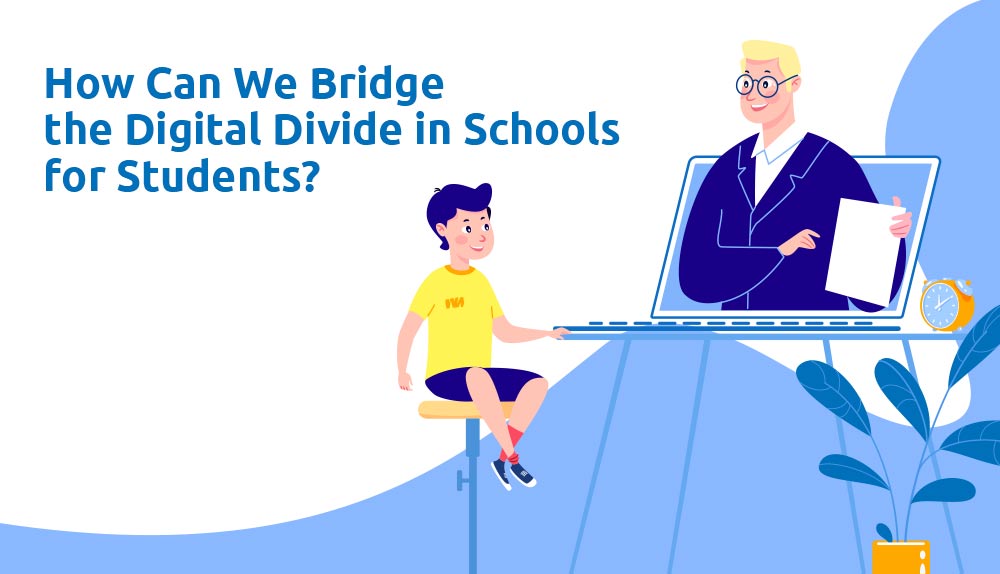Blogs
How Can We Bridge the Digital Divide in Schools for Students?

EdTech has paved the path for new possibilities in learning for humanity. Throughout the lockdown, digital learning solutions have been a terrific assist to youngsters and instructors. But it has also widened the digital divide among learners, preventing them from obtaining the equal stage of learning. The disparity is because some percentage of students have access to the latest computer systems, cell phones, and reliable net connections, digital content, and technological know-how while others do not. It is this technology gap that is referred to as the digital divide.
How is the Digital Divide Influencing Education?
The rise of digital education is propelled by well-known EdTech companies. The traditional blackboard classroom is giving way to a more digitised learning environment that includes digital content for schools, digital board for teaching and more. The importance of 21st-century skills like creativity, critical thinking, and digital literacy must be emphasised strongly in digital schools of India.
Still the truth is that a large percentage of students in India attend schools without EdTech infrastructure and reside in places with very low rates of digital adoption. Smartphone access is restricted and low-speed internet is only occasionally available on shared household devices. Due to pre-existing socio-economic disparities, this population already lacks digital learning solutions. The digital gap has grown due to an increased reliance on digital learning solutions, which has further excluded marginalised students in digital schools of India.
To ensure the continuance of high-quality education, the government must educate itself with the necessary knowledge of digital content for schools and digital board for teaching.
How Can We Overcome the Digital Divide Issue?
Social, economic, and political forces can work together to solve the problem of division in the digital world. Let's take a peek into some solutions that can assist in solving this problem:
1. The Government Needs to Become More Proactive
Policymakers and educational leaders should collaborate with governments and big corporations to significantly reduce the digital divide. They can help schools, learners, and teachers access digital content for schools, digital boards for teaching and other digital learning solutions at cost-effective prices and at a significant scale.
2. More Digital Learning
To enhance educational standards, teachers and students must get comprehensive training in using digital tools. In order to apply state-of-the-art digital content for schools, digital board for teaching and digital learning solutions in the classroom must be used. Schools must collaborate with the government to establish technical learning curriculums, conduct seminars, and hold workshops.
3. Digital Awareness
Culture differences and social concerns are major roadblocks to digital progress. In order to develop initiatives that promote digital literacy, public and private organisations must work together. Street plays, graphic presentations, one-on-one conversations, and other engaging methods of teaching people about digital literacy are available.
4. Use of Regional Languages in Online Teaching Resources
People feel more connected to content when they read it in their local language. Educators should create more contextualised online learning resources in native languages to reach out to a more significant number of students and teachers. Online digital schools in India should focus on including digital content for schools in local languages in their programmes.
5. Special Resources for Students Who are Physically Disabled
Teachers should focus on making digital learning accessible for differently abled students. There are several modern technologies that can help students, including laptops and tablets to help them learn in a variety of ways.
6. Addressing Social Issues
Social inequalities exist throughout the world and have a significant impact on the digital divide. The prejudice against women might potentially be a major roadblock to technological advancement. Today, women who want to use digital technology must get both financial and social support. Governmental entities and non-profit groups ought to develop programmes to nudge women into greater use of technology.
Introducing children to community-shared devices and offering a contextualised and localised digital repository has the potential to bridge the digital divide. This will give children access to technology-aided learning materials and help bridge the digital divide in school for students.





